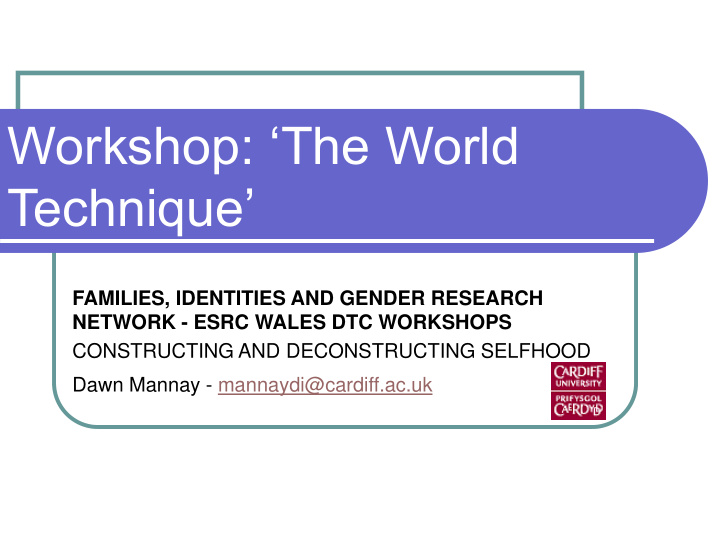



Workshop: ‘The World Technique’ FAMILIES, IDENTITIES AND GENDER RESEARCH NETWORK - ESRC WALES DTC WORKSHOPS CONSTRUCTING AND DECONSTRUCTING SELFHOOD Dawn Mannay - mannaydi@cardiff.ac.uk
Overview Working with the visual The World Technique Ethical qualitative inquiry Written in the sand Activity and Reflection
Visual Methodologies Previous engagement with the visual (Mannay 2010; 2013) Making the familiar strange (Delamont and Atkinson 1995) Defamiliarisation Power and participatory methods Auteur theory (Rose 2001) Unforeseen disclosures and ethical dilemmas (Mannay 2011)
Vision and Visuality Vision simply refers to the physiological capabilities of the human eye, whilst visuality accounts for the complex ways in which vision is constructed. Visuality and the overlapping term scopic regime, refer to the ways in which audiences bring their own ways of seeing and other knowledges to bear on an image (Rose 2001)
Interpretation
Subjectivity, Audiencing, Reading
Visual Journeys - Familiarity
Visual Journeys – Participant Led?
Visual Journeys - Ethics
The World Technique Sand therapy - NOT Freudian or Jungian Lowenfeld (1939) – ‘world technique’ Do not attempt to interpret the symbolism of the world but rather wait for the meanings to be identified by the child, ‘in recognition of the multiplicity of meanings the world may contain’ Figures in the sand tray become a primary vehicle for intra-personal and inter-personal communication, where ‘each figure holds unique and personal meaning for individuals’
The Studies University Challenge and LACE Project Participants created three-dimensional scenes, pictures or abstract designs in a tray filled with sand and a range of miniature, realistic and fantasy, figures; and everyday objects to reflect their educational experience Elicitation interviews – auteur theory Engage participants at the level of affect
Psychoanalytically Informed Should we take psychoanalysis outside of the clinical situation of the ‘consulting room’? (Frosh 2010) Should we be engaging with a psychoanalytically informed technique in the absence of a trained therapist? Explore the boundaries sensitive topics (Dickson-Swift 2006)
Interior Experience For Lowenfeld (1950), the action of making worlds can in itself begin the process of amelioration in the disturbances and discomforts Interior experience persists throughout the life course and is of profound importance but has so far been insufficiently studied It is this aspect of the interior life that the ‘world technique’ can elicit
Isolation in the Academy They were all the same and were friends and I was just this sort of strange entity in the lecture theatre You feel quite isolated
Work Life Balance I partially buried her because she’s like in quick sand, because there’s too much for one person to do I had to some how be a magician to keep everyone happy
No Entry ‘Do not enter’ is there, obscuring the way, because I don’t know the way Menacing man is, that I always feel like somebody is going to find out that I shouldn’t be here. And kick me out
Aspiration – LACE Project
Sandboxing Activity Please create a sand scene that reflects a transition in your life, for example the first few months in university, in a new job or becoming a parent. Discuss your sand scene with your group
Sandboxing Discussion The World Technique (Lowenfeld 1979) Elicitation interview Preferences Differences Advantages Disadvantages
Concluding Thoughts Lowenfeld (1950, p. 325) writes, ‘I am anxious that my whole research and therapeutic method, of which this equipment is part, should not be misunderstood or distorted when part of the equipment is borrowed and adapted for a different purpose’. I hope that Lowenfeld would see this development as respectful to her original work; and see its potential as a tool of qualitative inquiry; to extend the parameters of visual methods, to fight familiarity, to engage with subjective worlds of participants, and ultimately to contribute to informed policy initiatives.
References Delamont, S. and Atkinson, P. 1995. Fighting Familiarity: Essays on Education and Ethnography . Cresskill, NJ: Hampton Press. Dickson-Swift, V., James, E. L., Kippen, S. and Liamputtong, P. 2006. Blurring boundaries in qualitative health research on sensitive topics. Qualitative Health Research, 16 (6): 853-871 Frosh, S. 2010 . Psychoanalysis outside the clinic: interventions in psychosocial studies . Basingstoke: Macmillan. Lowenfeld, M 1979. The world technique . London: Allen and Uwin Press Mannay, D. 2010. ‘Making the Familiar Strange: Can Visual Research Methods Render the Familiar Setting more Perceptible?’, Qualitative Research 10 (1): 91-111. Mannay, D. 2011. Taking refuge in the branches of a guava tree: the difficulty of retaining consenting and non- consenting participants’ confidentiality as an indigenous researcher. Qualitative Inquiry 17(10), pp. 962-964. Mannay, D. 2013. ‘Who put that on there... why why why?:’ Power games and participatory techniques of visual data production. Visual Studies , 28 (2): 136-146 Mannay, D. 2015. Visual, narrative and creative research methods: application, reflection and ethics . London: Routledge. Mannay, D. and Edwards, V. 2015. ‘Coffee, Milk and a Sprinkling of Sand: an Initiative to Assist Non- traditional, Mature Students form Supportive Networks in Higher Education’, Proceedings of the Forum for Access and Continuing Education 2014 Annual Conference . London: Forum for Access and Continuing Education.
Recommend
More recommend